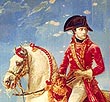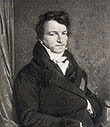| |
| |
EDITORIAL
EMBARRASSMENT OF RICHES?
Readers often find themselves in a quandary when presented with two books on the same subject. Such is the case in France this week with two books being published on the battle of Waterloo. How do you choose between Andrew Roberts', Waterloo. Le dernier pari de Napoléon, (De Fallois) (a French translation of Waterloo: Napoleon's Last Gamble, mentioned here on Napoleon.org) and Jean-Marc Largeaud's, Napoléon et Waterloo: la défaite glorieuse de 1815 à nos jours (Boutique de l'Histoire) before having read them?
First of all there's the "physical" volume. A person in a hurry could perhaps be drawn towards Roberts's tome: 187 pages as opposed to 465 for Largeaud. Those on a tighter budget might lean the same way: 18 euros for Roberts, 35 for Largeaud. There's no difference if you're "hard of sight" since the font sizes are more or less the same, but in terms of the cover, Roberts again noses ahead since Largeaud's jacket is somewhat austere.
You could also consider the publishers. Both have a highly recommendable 'Napoleonic' past. De Fallois published the French translation of Steven Englund's Napoleon, a political life whilst La Boutique de l'Histoire has produced Nathalie Petiteau's Noblesse d'Empire.
But then of course, there's the subject matter. On the one hand (Roberts), a small book resolutely anglophone in its outlook and references, with an anglophone bibliography (as if nothing had ever been written in French on the subject!!). In short, the book doesn't tell you much that you didn't know already. And you would learn nothing useful if you knew nothing about the battle in the first place. On the other hand, (Largeaud), a book which says something original: it recounts the history of the telling of the battle of Waterloo in France, starting from the battle itself. And for those who might fear that the battle itself takes a back seat, the 'blood and thunder' is indeed there behind each page, but enhanced by a great deal of material taken from memoirs and newspapers, telling the story of the creation of the great legends which grew around the battle. Naturally, Largeaud's books is not as easy to read as that by Roberts. But you soon forget this as the book carries you forwards and you no longer notice the slightly dry, academic tone.
So since good Napoleonic book are unfortunately rather rare, we would recommend you choose that by Jean-Marc Largeaud.
Thierry Lentz

|
|
|
| |
THIS MONTH'S ARTICLE
Was the Napoleonic regime a military dictatorship? by Thierry Lentz
It is generally agreed that the regime installed by Napoleon was authoritarian. But simply calling it a dictatorship seems excessive. In this deliberate critique of out-dated historiography, Thierry Lentz takes issue with unthinking repetition of traditional images of Napoleonic polity.
© Fondation Napoléon

|
|
|
| |
MINI DOSSIER: JACQUES DE NORVINS (1769-1854), HISTORIAN OF NAPOLEON
Author of the tremendously popular and influential L'Histoire de Napoléon (1827), Norvins was also a civil servant during the First Empire who moved in the background of the imperial family, first as secretary to Napoleon's brother-in-law Leclerc, then later as courtier to Jerome king of Westphalia. His books and his life were dedicated to the First Empire. Read all about it...
Jacques de Norvins © Fondation Napoléon

|
|
|
| |
TO REBUILD THE TUILERIES?
After the destruction by fire (and consequent dismemberment) of the Tuileries palace during the Comune period, reconstruction has frequently been mooted. Some politicians have made large promises but hard financial reality has always barred the route.
One man, however, Alain Boumier, President of the Académie du Second Empire, has leading the fight for the reconstruction against, it must be said, a great deal of opposition. Today, the debate seems once more to be on the table, in that the French minister of Culture, Renaud Donnedieu de Vabres, has just published government bill dated 6 June 2006 for the creation of a commission whose purpose is to consider the possibilities of the rebuilding of the Tuileries Palace...
Palais des Tuileries during the Second Empire © coll. Fondation Napoléon

|
|
|
| |
200 YEARS AGO
On 25 September, 1806 Napoleon left to join the Grande Armée: the campaign of 1806 was about to begin.
After Austerlitz Napoleon had offered George III's fief, Hanover, to Prussia, but after diplomatic wranglings and the deterioration of relations between Prussia and France, Napoleon had begun talks with Britain apparently suggesting giving it back to the British ruler. Frederick William's reaction came swiftly. On 25 August, 1806, Prussian troops were mobilised and sent towards Saxony, supported by Russian troops. On 18 September, 1806, Prussia declared war on France and on 19 September Napoleon gathered the Grande Armée.
On 26 September, 1806, a public exhibition of the produce of French industry opened in Paris. The exhibition was divided into two. The first part was a walk aligned with the portico of Les Invalides down to the Seine. The second was arranged in the office building of the Ponts-et-chaussées administration. Here on show stood the flower of French manufacturing: goldsmithery, jewellery, silks, porcelain, weaving, lace, etc. from more than 5,000 manufactories.
(Moniteur, 29 September, 1806)
150 YEARS AGO
Discovery:
The first chemical colorant was discovered in 1856 by the young British scientist, William Henry Perkin. Perkin was in fact working on synthesising quinine when he created a red-brown precipitate which, though unrelated to quinine, excited his curiosity. He had accidentally discovered a good-quality, synthetic chemical colouring for the textile industry, which he baptised aniline purple or mauveine. This was to be Perkin's moment of glory. Thereafter artificial colours were to be developed in large numbers in the 1860s, and by the 1880s they had replaced vegetal colorants.
Wishing you an excellent, Napoleonic, week.
Peter Hicks
Historian and Web editor
THE NAPOLEON.ORG BULLETIN, No 383, 22-28 September, 2006
Interested in the work of the Fondation Napoléon? Why not participate, either generally or in a specific project, by making a donation.
© this Napoleon.org weekly bulletin is published by the Fondation Napoléon. Reproduction or all or part of this bulletin is forbidden, without prior agreement of the Fondation Napoléon.

|
|
|
|
|
|
|
|
|
|
THIS WEEK in the MAGAZINE
JUST PUBLISHED
- SAMUELS Maurice, The Spectacular Past: Popular History and the Novel in Nineteenth-Century France
WHAT'S ON
Conferences
- Napoleonic Association Conference October 2006, Greenwich, London, UK
- Luigi Emanuele Corvetto (1756-1821), financier, lawyer and politician
Genoa–Imperia, Italy
Study Days
- Patrick O'Brian Weekend 2006, Portsmouth, UK
- Napoleon in North-East Italy, Isonzo Valley, Italy/Slovenia
Commemorations:
- Historical Bivouac 1806, Jena, Germany
Exhibitions
- Portraits publics, portraits privés 1770-1830, Grand Palais, Paris, France
- Louis Bonaparte and the Leiden powder explosion, Rotterdam, Netherlands
- Adel im Wandel (Changing nobility) Exhibition in the Prinzenbau and Landeshaus Sigmaringen, Germany
- Das Königreich Württemberg 1806–1918. Monarchie und Moderne (The kingdom of Württemberg 1806–1918. Monarchy and modernity) In the old castle, Stuttgart, Germany
- The price of the new crown: Baden and Wurttemberg as Napoleon's vassal – the Confederation of the Rhine 1806 Wehrgeschichtliches Museum Rastatt, Germany
- Louis Napoleon: at the court of the first King of Holland, 1806-1810, Apeldoorn, Netherlands
Got a problem with the letter? Try the home page: http://www.napoleon.org
<<
|
|




